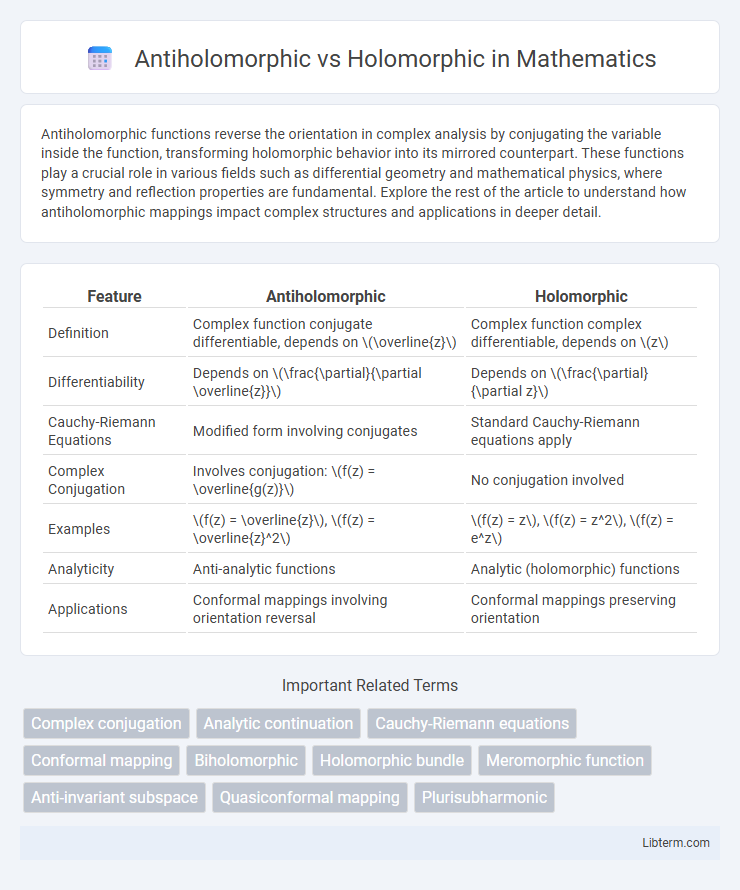Antiholomorphic functions reverse the orientation in complex analysis by conjugating the variable inside the function, transforming holomorphic behavior into its mirrored counterpart. These functions play a crucial role in various fields such as differential geometry and mathematical physics, where symmetry and reflection properties are fundamental. Explore the rest of the article to understand how antiholomorphic mappings impact complex structures and applications in deeper detail.
Table of Comparison
| Feature | Antiholomorphic | Holomorphic |
|---|---|---|
| Definition | Complex function conjugate differentiable, depends on \(\overline{z}\) | Complex function complex differentiable, depends on \(z\) |
| Differentiability | Depends on \(\frac{\partial}{\partial \overline{z}}\) | Depends on \(\frac{\partial}{\partial z}\) |
| Cauchy-Riemann Equations | Modified form involving conjugates | Standard Cauchy-Riemann equations apply |
| Complex Conjugation | Involves conjugation: \(f(z) = \overline{g(z)}\) | No conjugation involved |
| Examples | \(f(z) = \overline{z}\), \(f(z) = \overline{z}^2\) | \(f(z) = z\), \(f(z) = z^2\), \(f(z) = e^z\) |
| Analyticity | Anti-analytic functions | Analytic (holomorphic) functions |
| Applications | Conformal mappings involving orientation reversal | Conformal mappings preserving orientation |
Introduction to Holomorphic and Antiholomorphic Functions
Holomorphic functions are complex functions that are complex-differentiable at every point in an open subset of the complex plane, satisfying the Cauchy-Riemann equations. Antiholomorphic functions, in contrast, are complex functions that satisfy the conjugate form of the Cauchy-Riemann equations, involving differentiation with respect to the conjugate variable. Both concepts play a crucial role in complex analysis, with holomorphic functions exhibiting properties such as analytic continuation and conformality, while antiholomorphic functions often arise in the study of reflections and symmetries in complex geometry.
Fundamental Definitions and Distinctions
Holomorphic functions are complex functions that are complex-differentiable at every point within an open subset of the complex plane, satisfying the Cauchy-Riemann equations. Antiholomorphic functions, in contrast, are complex functions whose complex conjugates are holomorphic, effectively reversing the orientation and involving the conjugate variable \(\overline{z}\). The fundamental distinction lies in their dependence on \(z\) for holomorphicity versus \(\overline{z}\) for antiholomorphicity, impacting analytic continuation and conformal mapping properties.
Mathematical Foundations and Complex Analysis
Holomorphic functions are complex functions that are complex-differentiable at every point in an open subset of the complex plane, characterized by satisfying the Cauchy-Riemann equations, which ensure conformality and analyticity. Antiholomorphic functions, in contrast, are complex functions whose conjugates are holomorphic, involving the complex conjugate variable and reversing orientation in mappings. The distinction between holomorphic and antiholomorphic functions underpins key theorems in complex analysis, such as the distinction between analytic and anti-analytic components of functions, and has implications in fields like conformal mapping, complex dynamics, and the theory of Riemann surfaces.
Properties of Holomorphic Functions
Holomorphic functions are complex functions that are differentiable at every point within their domain, exhibiting analyticity and conformity. They satisfy the Cauchy-Riemann equations, ensuring the preservation of angles and orientation in the complex plane. Unlike antiholomorphic functions, which involve complex conjugation and reverse orientation, holomorphic functions maintain complex structure and enable powerful results such as contour integration and residue theorem applications.
Characteristics of Antiholomorphic Functions
Antiholomorphic functions are complex functions that are complex conjugates of holomorphic functions, meaning they depend on the conjugate variable \(\bar{z}\) rather than \(z\). These functions do not satisfy the Cauchy-Riemann equations for holomorphicity but instead fulfill a modified set involving conjugate derivatives. Antiholomorphic functions are anti-conformal, reversing orientation while preserving angles locally.
Key Theorems and Results
Holomorphic functions, characterized by complex differentiability, satisfy the Cauchy-Riemann equations and exhibit properties such as analyticity, conformality, and the existence of power series expansions within their domain. Antiholomorphic functions are conjugates of holomorphic functions, reversing orientation and satisfying modified Cauchy-Riemann conditions, playing key roles in reflections and elliptic PDE theories. Important theorems include the Cauchy Integral Theorem for holomorphic functions and the Schwarz Reflection Principle, which relates holomorphic and antiholomorphic extensions across real analytic curves.
Applications in Physics and Mathematics
Holomorphic functions, characterized by complex differentiability, are fundamental in complex analysis and quantum field theory, enabling precise solutions to differential equations and conformal mappings. Antiholomorphic functions, involving the complex conjugate variable, play crucial roles in theoretical physics, particularly in string theory and complex conjugate field formulations, aiding in duality and symmetry analyses. Both function types facilitate advanced mathematical models for physical phenomena, optimizing problem-solving in areas like fluid dynamics and electromagnetic theory.
Visualizing Holomorphic vs Antiholomorphic Mappings
Visualizing holomorphic mappings involves understanding complex functions that preserve angles and orientation, producing smooth, conformal transformations in the complex plane. In contrast, antiholomorphic mappings reverse orientation while still preserving angles, often represented by the complex conjugate of holomorphic functions. Graphical illustrations of these mappings show holomorphic functions as conformal grid distortions, whereas antiholomorphic functions demonstrate mirror-like reflections across the real axis or other symmetry lines.
Real-World Examples and Case Studies
Holomorphic functions, exemplified by complex analytic functions in fluid dynamics and electromagnetic field modeling, exhibit complex differentiability crucial for solving Laplace's equation with boundary conditions. Antiholomorphic functions appear in image processing, particularly in edge detection algorithms, where complex conjugation aids in identifying contrasting features. Case studies in quantum mechanics highlight holomorphic functions in wavefunction representations, whereas antiholomorphic functions facilitate symmetry operations and complex conjugate solutions.
Conclusion: Holomorphic vs Antiholomorphic
Holomorphic functions are complex functions that are complex differentiable at every point in their domain, preserving the orientation of the complex plane, while antiholomorphic functions are complex conjugates of holomorphic functions and reverse the orientation. In complex analysis, holomorphicity implies strong structural regularity and conformality, whereas antiholomorphic functions often appear in symmetry operations and reflections. Understanding the distinction between holomorphic and antiholomorphic mappings is crucial for applications in complex dynamics, conformal geometry, and theoretical physics.
Antiholomorphic Infographic

 libterm.com
libterm.com